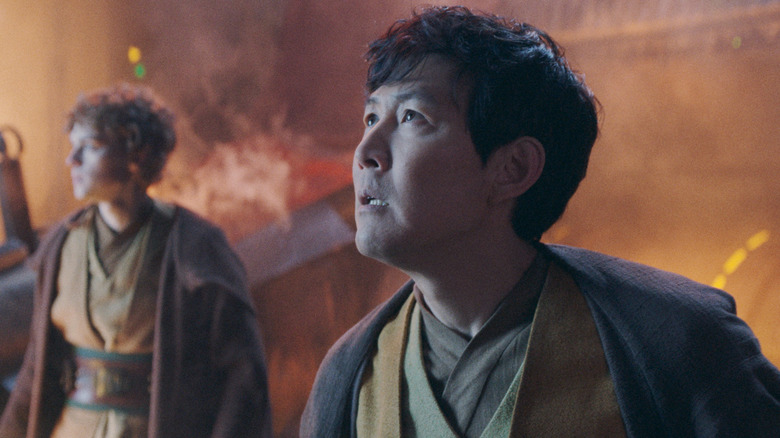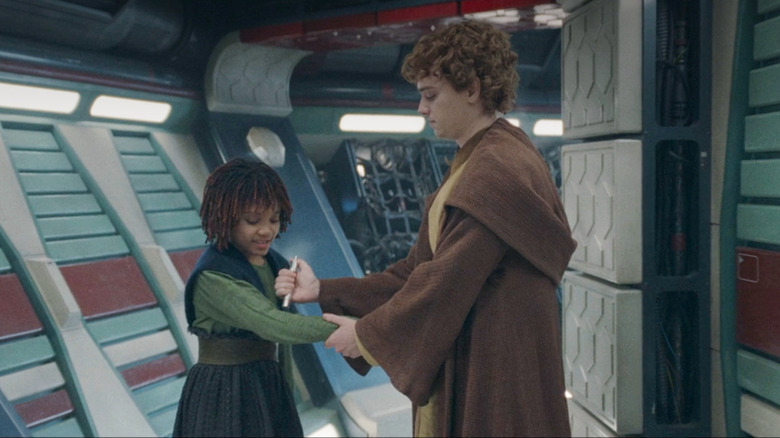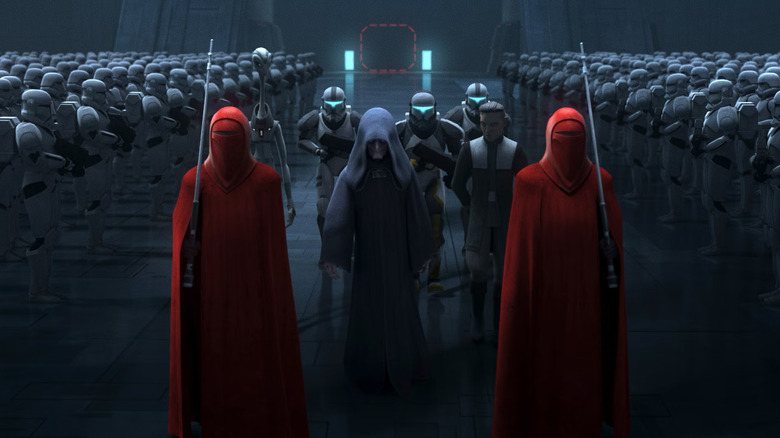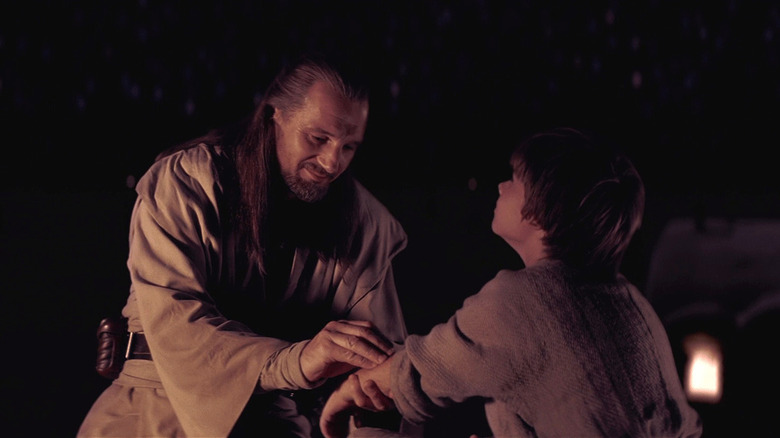The Acolyte May Have Unveiled A Sneaky Connection To The Biggest Star Wars Villain
This article contains spoilers for "Star Wars: The Acolyte" episode 7: "Choice."
It felt like a foregone conclusion that "The Acolyte" would be returning to the secret past of the planet Brendok and the events that led the twins Osha and Mae (Amandla Stenberg as the young adult versions, Leah and Lauren Brady as the child-aged iterations), as well as the other characters, onto their destined paths. In the third episode, "Destiny", we were introduced to this earlier timeline and only given bits of information about what happened. We were also provided with some tantalizing hints about what could possibly be going on with the planet, the Jedi, and the twins themselves, along with their mysterious circumstances. However, after the latest episode, it's apparent that Brendok, Mae, and Osha might all mean far more to the broader "Star Wars" mythos than we realized ... and one path leads directly to the doorstep of Darth Sidious.
The M-Count
Through the course of this episode, we're reminded that the young Padawan Torbin (Dean-Charles Chapman) has taken midi-chlorian samples from Mae and Osha. Though they don't offer a number for their strength in the Force, he does note that their M-count is exceedingly high. The concept of midi-chlorians were first introduced into the "Star Wars" canon proper in 1999's "Episode I — The Phantom Menace," yet only recently has the franchise started referring to it as an "M-count." The term came to common use in the most recent seasons of "Star Wars: The Bad Batch," which takes place in the immediate aftermath of the purge of the Jedi and the Imperial takeover of the Republic.
We know that Master Yoda also has a high midi-chlorian count, but that the Jedi had never seen a count higher than Anakin Skywalker's. This leads us to believe that Mae and Osha are special, but not the vergance in the Force that Anakin Skywalker was.
Things get curious when Torbin realizes that the symbiotes within Mae and Osha are exactly the same. Even as identical twins, they would have similar genetic code, but midi-chlorians are unique and separate. So, why would the symbiotes themselves be identical? It leads one to wonder about cloning and what other process Mother Aniseya (Jodie Turner-Smith) would have resorted to in order to create her children.
Operation: Necromancer
That brings us to Operation: Necromancer. This was Emperor Palpatine's effort to clone himself and his midi-chlorians so that he could possess a new body if, Force forbid, his apprentice dropped him down a reactor shaft or something. Overseen by Dr. Hemlock, Operation: Necromancer was featured heavily on "Star Wars: The Bad Batch" and was the pursuit of the exact process that resulted in Mae and Osha: the ability to create an exact copy of a Force user and maintain their ability in the Force.
The Empire wasn't quite successful until the very end, and even then, the shell that Palpatine was inserted to in time for "The Rise of Skywalker" was imperfect. It's no wonder that Palpatine would have been chasing these things and it ties Mae and Osha directly to his story.
With Mae and Osha presenting, at least on the surface from Torbin's readings, exact genetic replicas of not just their own DNA but that of the midi-chlorians within their cells, it seems this is the very gold that Palpatine was chasing in the hills of immortality.
A vergance in the Force
One of the things that could have contributed to Mae and Osha's existence is explained by Master Indara (Carrie-Anne Moss) as a vergance in the Force. This term was first used by Qui-Gon Jinn (Liam Neeson) in "The Phantom Menace" to describe Anakin, although he was shocked that this could be centered around a person. Indara feels that the planet of Brendok itself is a vergance in the Force as it was lifeless at the time of the great hyperspace disaster (the event that kicked off the events of the High Republic publishing program), and is now lush with life. This is something we've seen before — places strong in the Force where time can bend and the Force can show people things (or where strange things happen). Dagobah is one such place. Mortis is another. Qui-Gon also guides Yoda to the "Wellspring of Life" in "Star Wars: The Clone Wars," which was a similarly lush planet where the midi-chlorians were thought to have originated.
One thing is sure: Brendok holds mysteries of the Force and those mysteries fold into other mysteries.
The tragedy of Darth Plagueis the Wise
One of the largest mysteries in "Star Wars" is the tragedy of Darth Plagueis the Wise. Though it's not a story the Jedi would tell Anakin Skywalker, it seems to be a story that Sheev Palpatine is intimately familiar with. In "Revenge of the Sith," Palpatine explains to Anakin that Plagueis could manipulate the midi-chlorians into creating life. He also hints that this power is something only one has achieved. With more layers to Brendok still left to be revealed, could Mae and Osha prove to be the product of a deal with a Sith Lord? Could they have been the result of Plagueis' work? It would make sense why Palpatine is so desperately chasing the research of his master, not realizing before he killed him that there was still knowledge left to be gained.
Mae and Osha could very well be a missing key in understanding the recent history of the Sith and Palpatine's pursuit of forbidden knowledge to outlive his natural life and maintain his grasp of power across the galaxy. Hopefully, next week's "Acolyte" finale will tie at least some of this together. There is definitely a thought that Darth Plagueis himself might make an appearance in the episode (assuming he hasn't already...), and that would certainly turn the world of "Star Wars" on its ear in all of the best ways.
The finale of"Star Wars: The Acolyte" premieres on Tuesday, July 16 at 9pm EST, only on Disney+.




